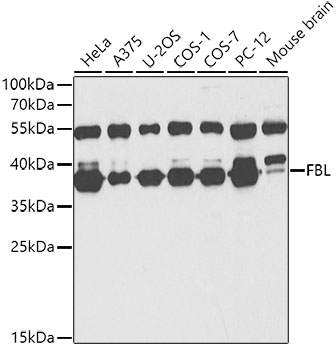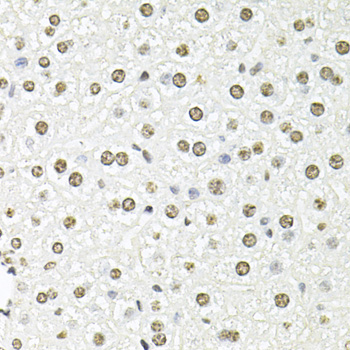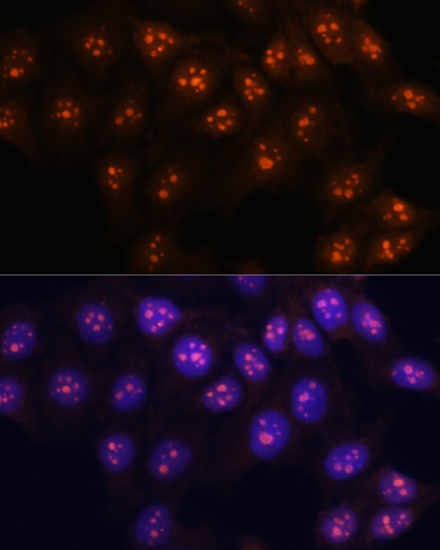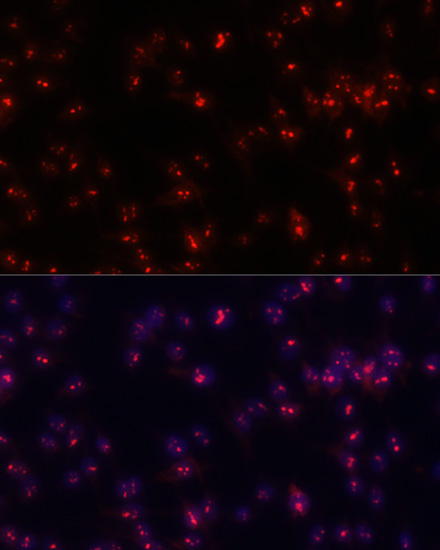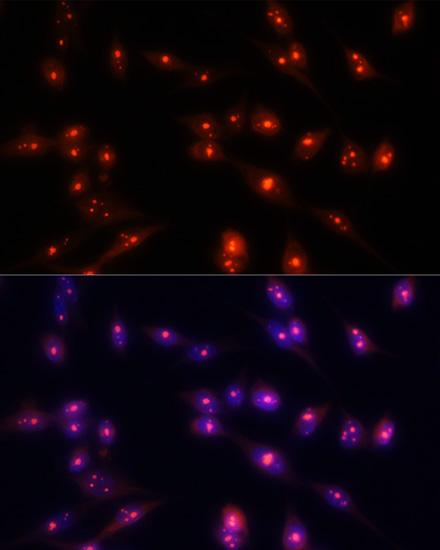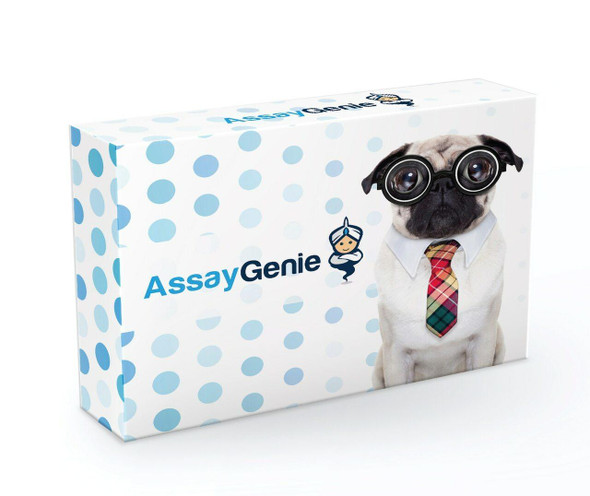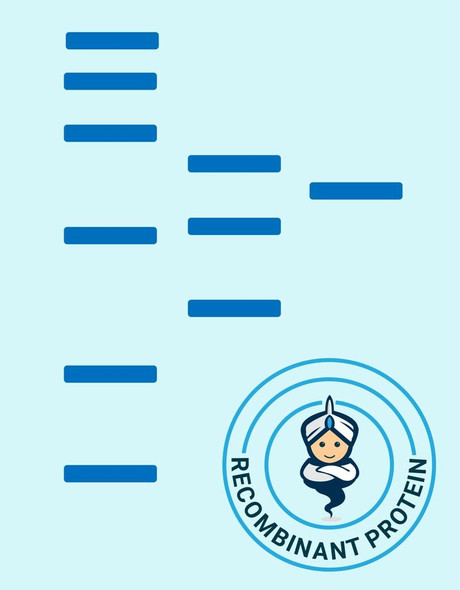Epigenetics & Nuclear Signaling Antibodies 1
Anti-FBL Antibody (CAB13490)
- SKU:
- CAB13490
- Product Type:
- Antibody
- Reactivity:
- Human
- Reactivity:
- Mouse
- Reactivity:
- Rat
- Reactivity:
- Monkey
- Host Species:
- Rabbit
- Isotype:
- IgG
- Antibody Type:
- Polyclonal Antibody
- Research Area:
- Epigenetics and Nuclear Signaling
Description
| Antibody Name: | Anti-FBL Antibody |
| Antibody SKU: | CAB13490 |
| Antibody Size: | 20uL, 50uL, 100uL |
| Application: | WB IHC IF IP |
| Reactivity: | Human, Mouse, Rat, Monkey |
| Host Species: | Rabbit |
| Immunogen: | Recombinant fusion protein containing a sequence corresponding to amino acids 100-321 of human FBL (NP_001427.2). |
| Application: | WB IHC IF IP |
| Recommended Dilution: | WB 1:500 - 1:2000 IHC 1:50 - 1:200 IF 1:50 - 1:200 IP 1:20 - 1:50 |
| Reactivity: | Human, Mouse, Rat, Monkey |
| Positive Samples: | HeLa, A375, U-2OS, COS-1, COS-7, PC-12, Mouse brain |
| Immunogen: | Recombinant fusion protein containing a sequence corresponding to amino acids 100-321 of human FBL (NP_001427.2). |
| Purification Method: | Affinity purification |
| Storage Buffer: | Store at -20'C. Avoid freeze / thaw cycles. Buffer: PBS with 0.02% sodium azide, 50% glycerol, pH7.3. |
| Isotype: | IgG |
| Sequence: | RGKE DALV TKNL VPGE SVYG EKRV SISE GDDK IEYR AWNP FRSK LAAA ILGG VDQI HIKP GAKV LYLG AASG TTVS HVSD IVGP DGLV YAVE FSHR SGRD LINL AKKR TNII PVIE DARH PHKY RMLI AMVD VIFA DVAQ PDQT RIVA LNAH TFLR NGGH FVIS IKAN CIDS TASA EAVF ASEV KKMQ QENM KPQE QLTL EPYE RDHA VVVG VYRP PPKV KN |
| Gene ID: | 2091 |
| Uniprot: | P22087 |
| Cellular Location: | Nucleus, nucleolus |
| Calculated MW: | 33kDa |
| Observed MW: | 37kDa |
| Synonyms: | FBL, FIB, FLRN, RNU3IP1, Nop1 |
| Background: | This gene product is a component of a nucleolar small nuclear ribonucleoprotein (snRNP) particle thought to participate in the first step in processing preribosomal RNA. It is associated with the U3, U8, and U13 small nuclear RNAs and is located in the dense fibrillar component (DFC) of the nucleolus. The encoded protein contains an N-terminal repetitive domain that is rich in glycine and arginine residues, like fibrillarins in other species. Its central region resembles an RNA-binding domain and contains an RNP consensus sequence. Antisera from approximately 8% of humans with the autoimmune disease scleroderma recognize fibrillarin. |
| UniProt Protein Function: | FBL: Involved in pre-rRNA processing. Utilizes the methyl donor S-adenosyl-L-methionine to catalyze the site-specific 2'- hydroxyl methylation of ribose moieties in pre-ribosomal RNA. Site specificity is provided by a guide RNA that base pairs with the substrate. Methylation occurs at a characteristic distance from the sequence involved in base pairing with the guide RNA. Interacts with NOLC1. Component of box C/D small nucleolar ribonucleoprotein (snoRNP) particles that contain NHP2L1, FBL, NOP5 and NOP56, plus a guide RNA. It is associated with the U3, U8, U13, X and Y small nuclear RNAs. Component of several ribosomal and nucleolar protein complexes. Interacts with PRMT5 and UTP20. Interacts with DDX5. Belongs to the methyltransferase superfamily. Fibrillarin family. |
| UniProt Protein Details: | Protein type:EC 2.1.1.-; RNA-binding; Nucleolus; Methyltransferase; RNA processing Chromosomal Location of Human Ortholog: 19q13.1 Cellular Component: Cajal body; granular component; membrane; nucleolus; nucleus Molecular Function:protein binding; RNA binding Biological Process: osteoblast differentiation; snoRNA metabolic process; tRNA processing; rRNA processing |
| NCBI Summary: | This gene product is a component of a nucleolar small nuclear ribonucleoprotein (snRNP) particle thought to participate in the first step in processing preribosomal RNA. It is associated with the U3, U8, and U13 small nuclear RNAs and is located in the dense fibrillar component (DFC) of the nucleolus. The encoded protein contains an N-terminal repetitive domain that is rich in glycine and arginine residues, like fibrillarins in other species. Its central region resembles an RNA-binding domain and contains an RNP consensus sequence. Antisera from approximately 8% of humans with the autoimmune disease scleroderma recognize fibrillarin. [provided by RefSeq, Jul 2008] |
| UniProt Code: | P22087 |
| NCBI GenInfo Identifier: | 14549159 |
| NCBI Gene ID: | 2091 |
| NCBI Accession: | P22087.2 |
| UniProt Secondary Accession: | P22087,O75259, Q6IAT5, Q9UPI6, B5BUE8, |
| UniProt Related Accession: | P22087 |
| Molecular Weight: | 321 |
| NCBI Full Name: | rRNA 2'-O-methyltransferase fibrillarin |
| NCBI Synonym Full Names: | fibrillarin |
| NCBI Official Symbol: | FBL |
| NCBI Official Synonym Symbols: | FIB; FLRN; RNU3IP1 |
| NCBI Protein Information: | rRNA 2'-O-methyltransferase fibrillarin; 34-kD nucleolar scleroderma antigen; histone-glutamine methyltransferase; 34 kDa nucleolar scleroderma antigen; RNA, U3 small nucleolar interacting protein 1 |
| UniProt Protein Name: | rRNA 2'-O-methyltransferase fibrillarin |
| UniProt Synonym Protein Names: | 34 kDa nucleolar scleroderma antigen; Histone-glutamine methyltransferase |
| Protein Family: | rRNA 2'-O-methyltransferase fibrillarin |
| UniProt Gene Name: | FBL |
| UniProt Entry Name: | FBRL_HUMAN |
View AllClose


